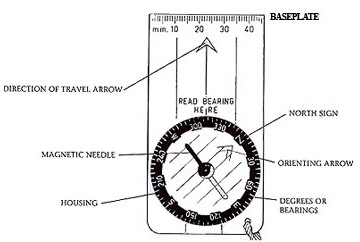Reading a compass seems like an intimidating skill to many people. However, once you learn the basics and practice a little, you will find that you can read a compass with ease. This skill is useful for those who like to hike in the wilderness, and is important for sports like orienteering. These directions are based on the commonly used compass in the illustration below. Make sure you know how to use your particular compass before heading out.
Parts of a Compass
The first step to reading a compass is to understand its parts:
- The base plate is the surface on which the compass is mounted, usually a hard rectangular piece of plastic.

- The housing is the main part of the compass. It is a round plastic container that has the compass needle inside. It can be turned so you can select different bearings (degrees) for your direction of travel.
- The direction-of-travel arrow is marked on the base plate. When traveling, you point this arrow directly away from you and move in the direction it is pointing.
- The orienting arrow is marked in the housing. It rotates when the dial is turned.
- The magnetic needle turns freely within the housing. It has one end painted red to indicate north.
- A compass is divided into 360 degrees for precise locations using latitude and longitude. The cardinal points are marked on the outer ring of the housing. North is at 0 degrees (and 360 degrees), east is 90 degrees, south is 180 degrees, and west is 270 degrees.
How to Read a Compass
Now it is time to read your compass:
- Decide which direction you’d like to travel and rotate the housing until the bearing number you’d like is lined up with the “read bearing here” mark. For example, to head due north, rotate the housing until the 0 deg
 ree mark is lined up.
ree mark is lined up. - Hold your compass flat and still in the palm of your hand (and against your chest) so the base plate is level and the direction-of-travel arrow is pointing straight away from you. The magnetic needle should be able to move freely, without bumping the top or bottom of the housing.
- Look down at the compass and see where the needle points.
- Turn your entire body until the magnetic needle is centered between the red lines, as shown in the figure to the right. This is referred to as “keeping the red in the shed.” Make sure to do this; it will keep you heading in the right direction. The compass in our example is pointing due north (also 0 degrees).
- To determine the bearing of an object in the distance, face the object with the compass held flat in your palm as before. This time, rotate the housing until the red end of the magnetic needle is between the red lines, and “in the shed.” Read the bearing number at “read bearing here.” In the example shown below, you are heading 250 degrees west.

Follow our occasional Tweets @WinterCampers
SHARE
October 15th, 2011 | Tags: compass, education, training | Category: Winter Camping, Winter Camping Skills
Comments are closed.

